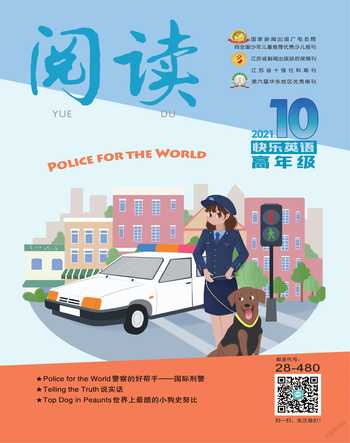彼得兔一家的丰收晚宴
徐小红






彼得兔一家有一个小小的菜园。金秋时节,菜园里的瓜果丰收了,彼得兔邀请刺猬、小猪和松鼠来参加丰收晚宴。
刺猬:There are so many vegebables on the table. 有这么多的蔬菜。
There are picked tomatoes and potatoes.有精选的西红柿和土豆。
彼得兔:And there are a lot of carrots in my hands. Haha!
哈哈,我手里还有很多胡萝卜呢!
松鼠:There’s some beer in the bottle. 瓶子里有一些啤酒。
There are five bottles of whisky. 有5瓶威士忌酒。
小猪:There’s some jam on the plate. 盘子里有果酱。
朋友們看到这么多美食,开心极了。他们叽叽喳喳地说着,笑着,分享着丰收的喜悦。
彼得兔的爸爸托马斯先生惊讶地说:“真没想到,这群孩子居然还会用There be句型!”妈妈比伊太太笑了起来:“可别小瞧他们啊!孩子们虽然调皮了点儿,可是学起语法来一点就通!”
There be句型表示存在,用来描述某地有某物。陈述句的结构为“There be +人/物+地点状语”。
1. There be后接可数名词时,如名词是单数,be动词用is;名词是复数,be动词则用are。如:
There is an orange on the table. 桌上有一个橘子。
There are many books on the bookshelf. 书架上有许多书。
2. 如果在同一个句子中既有单数名词,又有复数名词,那就要遵循“就近原则”,be动词的变化取决于离它最近的那个名词。如:
There is a car and two bikes in the picture.
图中有一辆汽车和两辆自行车。
There are two bikes and a car in the picture.
图中有两辆自行车和一辆汽车。
3. There be后如果接不可数名词,be动词用is。如:
There is some apple juice in the glass. 杯子里有一些苹果汁。
★要特别注意下面这个句子:
There is a pair of shoes under the bed. 床底下有一双鞋。
其中,a pair of的意思是“一双”,是单数,所以be动词用is。
小猫:Look, there isn’t any fruit on the table now.看,桌上没有水果了。
There aren’t any apples. 没有苹果。
There aren’t any grapes and peaches, either.也没有葡萄和桃子。
小猪:There are no bananas. 没有香蕉。
There are no oranges and pears, either. 也没有橘子和梨子。
比伊:Is there any fruit on the table now? 现在桌上有水果吗?
All: No, there isn’t.没有。
“看来今年的水果格外好吃,大家很快就吃光了。”托马斯先生说道。比伊太太笑着说:“我们家还有很多水果呢,我再拿一些来。”
1. There be句型的否定形式,是在be动词后面加not。其中有两点要注意:首先,肯定句中表示“一些”用some,在否定句中应使用any;其次,isn’t = is not, aren’t = are not。如:
There isn’t a bird in the tree. 树上没有一只鸟。
There isn’t any juice in the bottle. 瓶子里没有果汁。
There aren’t any cakes here.这儿没有蛋糕。
2. 在be动词的后面加上no表示“没有”。如:
There is no milk at home. 家里没有牛奶。
There are no books on the desk. 书桌上没有书。
3. There be句型的一般疑问句,是把陈述句中的be动词提到句首,句中如果有some改成any,句末标点改为问号。如:
Is there an egg on the plate? 盘子里有一个鸡蛋吗?
Is there any water in the glass? 这个杯子里有一些水吗?
Are there any biscuits here? 这儿有一些饼干吗?
根据具体情境中名词的不同,回答有肯定和否定两种形式:
Yes, there is /are.和No, there isn’t /aren’t.
大家端坐在餐桌前,品尝着各种美食。闲谈间,他们不禁想起了麦奎格爷爷。
松鼠:麦奎格爷爷在世的时候,把他的菜园子照顾得很好。
There were fresh cabbages and lettuces. 有新鲜的卷心菜和莴苣。
There were peas and beans, too. 还有豌豆和豆角。
彼得兔:There were many fruit trees in the garden. 菜园里还有许多果树。
There was a scarecrow in the middle of the garden. My blue jacket was on it.菜园中间有个稻草人。我的蓝色夹克穿在它身上。
But later, there were not any fresh vegetables and fruit in his garden.
但是后来,他的菜园里没有新鲜的蔬菜和水果了。
一般过去时表示过去某个时间里发生的动作或状态,There be句型在一般过去时中的用法和在一般现在时中的用法类似,但要把be 動词is改成was, 把are改成were。如:
There was an old house on the hill. 山上有一座老房子。
There was some watermelon juice in the fridge. 冰箱里有一些西瓜汁。
There were many people in the park. 公园里有许多人。
There wasn’t a kite in the sky. 天空中没有一只风筝。
There wasn’t a pair of socks on the sofa. 沙发上没有一双袜子。
There wasn’t any water in the glass. 杯子里没有水。
There weren’t many balloons at the party. 舞会上没有许多气球。
Was there a little boy in the street? 街上有个小男孩吗?
Was there any tea in the teapot? 茶壶里有一些茶吗?
Were there many fish in the river? 小河里有许多鱼吗?
根据具体情境中名词的不同,回答有肯定和否定两种形式:
Yes, there was / were.和No, there wasn’t / weren’t.
刺猬:麦奎格爷爷虽然不在了,但他永远在我们心中。
托马斯:今天可是要庆祝丰收哟,让我们一起举杯吧!
Ouch, what’s in my glass? 哎哟, 我的杯子里有什么?
比伊: My god! There is a ladybird in your glass.
天啊,你的杯子里有一只瓢虫。
There was a ladybird on the table just now.
刚才桌子上有一只瓢虫。
托马斯:Look carefully! How many ladybirds are there in my glass?
看仔细了!我杯子里有多少只瓢虫?
比伊: Two! Two ladybirds! There are two ladybirds in your glass now.
两只!两只瓢虫!你杯子里现在有两只瓢虫了。
彼得兔:Haha...
朋友们谁也不知道,杯子里的瓢虫是淘气包彼得兔偷偷放进去的!
There be句型的特殊疑问句:
1. 问可数名词的数量,用“How many +可数名词复数+ are there +地点?”不管回答是单数还是复数,问句都用复数形式。如:
How many students are there in the classroom? 教室里有多少学生?
There is only one. 只有一个。
2. 问不可数名词的数量用“How much + is there +地点?”如:
How much juice is there in the glass? 杯子里有多少果汁?
3. 问某地有什么,用“What’s +地点?”不管回答是单数还是复数,问句都用“What’s”,如:
What’s in the room? 房间里有什么?
There are three beds. 有三张床。
★和sb. have / has sth.这一句型相比,There be句型强调存在,主语在be动词之后,通常是物,也可以是人;Have 和has强调某人拥有某物,主语在前,通常是人。

